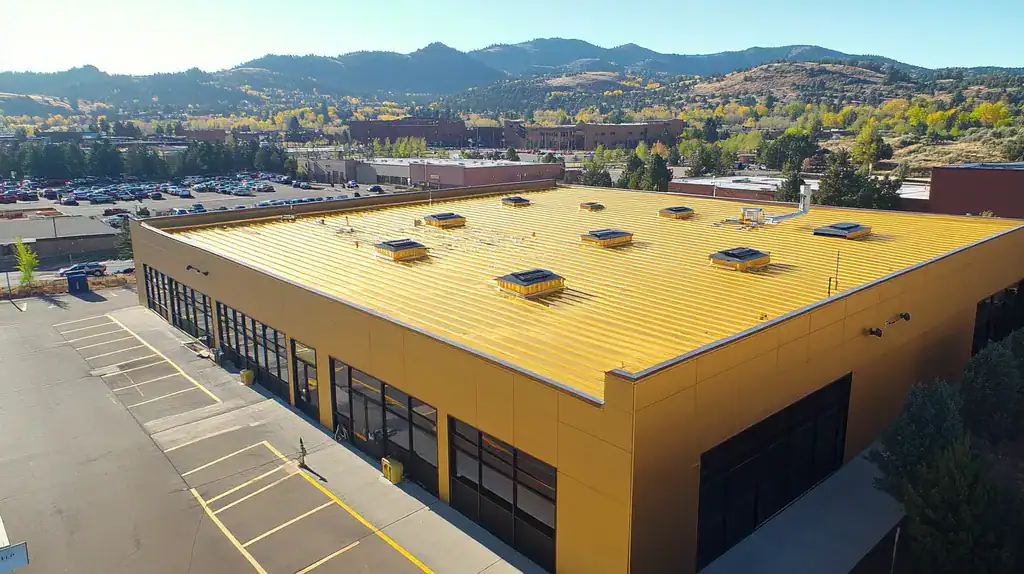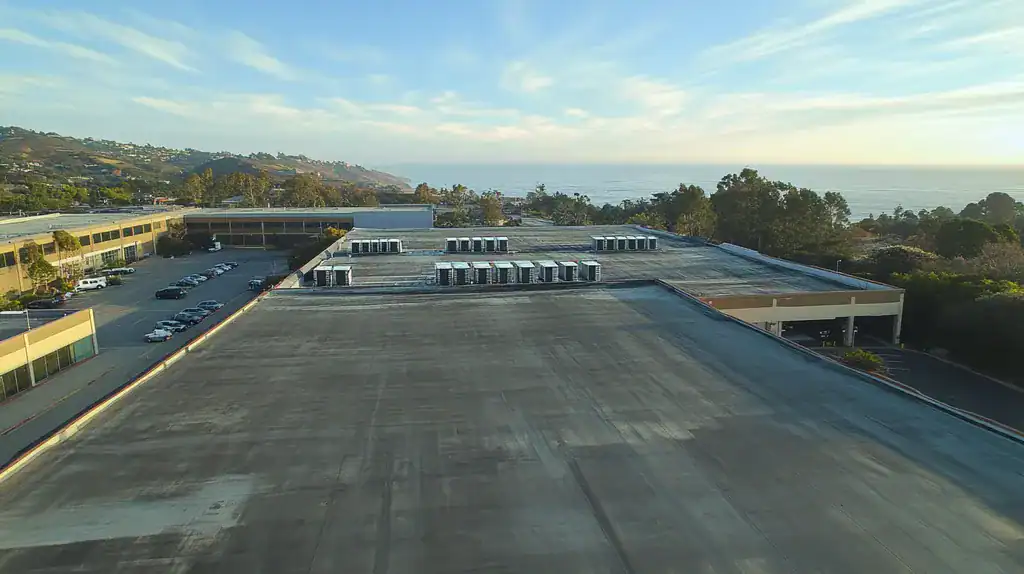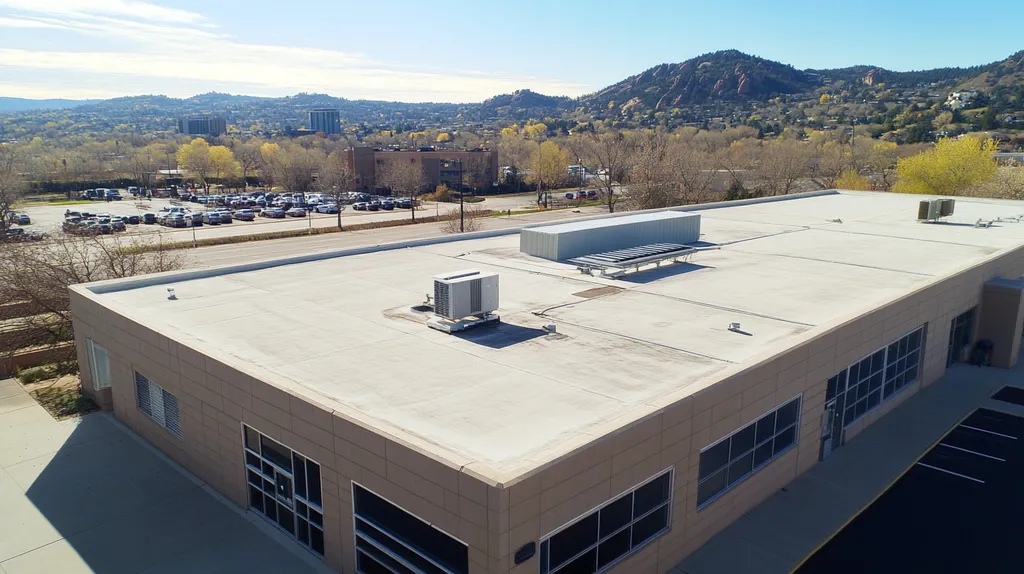Welcome to today’s Battle Royale featuring two roofing heavyweights: “EPDM” in the east corner versus “TPO” in the west!
Tonight’s showdown pits these contenders against each other across six punishing rounds designed to test every aspect of their performance for Industrial Roof Lifespan Weather Pattern requirements.
At stake? Millions in potential costs, decades of building protection, and the critical performance demands of modern commercial and industrial facilities.
Our professional judging panel will evaluate each round on technical merit, real-world performance, and value delivery. After all six rounds, we’ll declare our ultimate champion.
Ladies and gentlemen, facility managers and building owners… it’s time to rumble!
ROUND 1: INITIAL COSTS & INSTALLATION
When industrial roofing decisions go wrong, the consequences can be devastating. A poorly chosen roofing system can lead to premature failure, requiring complete replacement years ahead of schedule and costing hundreds of thousands in unexpected expenses. Insurance coverage may not help either – policies typically exclude damage resulting from improper maintenance or installation choices.
Material Expenses
The Insurance Information Institute emphasizes that insurance policies won’t cover damage from inadequate maintenance or poor material choices, making initial material selection critically important. (source: Insurance Information Institute)
EPDM membrane costs typically range from $0.85 to $1.50 per square foot for materials alone, making it one of the most economical choices for large industrial installations. The material’s uniform black surface requires minimal specialized components.
TPO materials generally cost 30-50% more than EPDM, ranging from $1.50 to $3.00 per square foot. This higher cost stems from more complex manufacturing processes and specialized surface treatments.
For pure material costs, EPDM claims an “ADVANTAGE” due to its significantly lower price point and simpler composition.
Installation Complexity
Installation complexity directly impacts both immediate costs and long-term performance. Proper installation is essential for achieving the full lifespan potential of any roofing system.
EPDM installation uses straightforward techniques that most qualified roofing crews can master quickly. The material can be adhered using standard methods, and seams are sealed using proven tape or adhesive systems.
TPO requires specialized hot-air welding equipment and trained technicians to properly fuse the seams. This technical requirement increases both labor costs and the potential for installation errors.
Given its simpler installation requirements and lower technical barriers, EPDM earns an “ADVANTAGE” in this category.
Project Timeline
Every day of roofing work can disrupt normal business operations. Faster completion means less exposure to weather risks during installation and quicker return to normal operations.
EPDM installations typically progress rapidly due to large sheet sizes and simple seaming methods. Most crews can complete 5,000-10,000 square feet per day under normal conditions.
TPO installation moves more slowly due to the technical nature of heat-welded seams and the need for specialized equipment. Daily completion rates average 3,000-7,000 square feet.
With faster average installation speeds and fewer technical delays, EPDM claims another clear “ADVANTAGE” in project timeline considerations.
ROUND 1 WINNER: EPDM
ROUND 2: DURABILITY & LIFESPAN
Weather patterns can dramatically accelerate roof deterioration, turning a 20-year roof system into a 10-year liability. The constant assault of UV radiation, temperature swings, and moisture creates unique challenges for industrial roofing materials. Understanding how EPDM and TPO respond to these stressors is crucial for making cost-effective roofing decisions.
Impact of UV Exposure
UV radiation represents one of the most destructive forces affecting industrial roofs. Weather conditions play a crucial role in determining material longevity, with UV exposure causing gradual degradation of chemical bonds in roofing membranes. (source: RNC)
EPDM’s carbon black content provides natural UV resistance, allowing the material to maintain its physical properties for decades. The membrane’s molecular structure remains stable even under intense sun exposure, contributing to its documented 30+ year lifespan.
TPO relies on chemical UV stabilizers and reflective properties for protection. While effective initially, these protective elements can degrade over time, especially in regions with high UV indexes. Surface erosion becomes increasingly likely as the material ages.
For long-term UV resistance, EPDM claims a clear ADVANTAGE.
Temperature Resilience
Daily temperature cycles stress roofing materials through constant expansion and contraction. This thermal movement can lead to membrane fatigue and eventual failure if not properly accommodated.
EPDM maintains flexibility across an impressive temperature range, from -40°F to 300°F. This elasticity allows the material to move with the building structure while maintaining watertight integrity.
TPO becomes increasingly rigid in cold temperatures and can develop stress cracks at membrane seams. High temperatures may cause sheet distortion and potential delamination of reinforcement layers.
Given its superior thermal stability, EPDM earns another ADVANTAGE.
Water Resistance
Industrial roofs must maintain watertight performance despite persistent moisture exposure. Standing water, driven rain, and ice damming create constant challenges for membrane integrity.
EPDM offers excellent resistance to ponding water and maintains its waterproof properties even under prolonged exposure. The material’s chemical inertness prevents water absorption and degradation.
TPO performs adequately when properly installed but shows greater sensitivity to standing water conditions. Seam reliability can decrease over time, particularly in areas prone to ponding.
Based on long-term water resistance performance, EPDM demonstrates an ADVANTAGE.
ROUND 2 WINNER: EPDM
ROUND 3: PERFORMANCE FACTORS
When extreme weather events strike, industrial roofs face their ultimate test. Severe storms, temperature fluctuations, and moisture intrusion can dramatically reduce a roof’s expected lifespan, turning what should be a 20-year installation into a premature failure. The performance differences between EPDM and TPO become most apparent during these challenging conditions.
Weather Resistance
Severe weather events can reduce a roof’s expected lifespan by up to 30%, making weather resistance a critical performance factor. (source: Stronghold Roofing)
EPDM membranes maintain their physical properties even under extreme conditions, with their molecular structure remaining stable through intense storms, hail, and wind events. The material’s flexibility allows it to absorb impacts without compromising its integrity.
TPO systems, while initially resilient, can become more vulnerable to damage over time. Their heat-welded seams may weaken under repeated stress from extreme weather cycles, particularly in areas experiencing frequent storms.
For overall weather resistance, EPDM claims an “ADVANTAGE” due to its superior durability in extreme conditions.
Thermal Performance
Daily temperature fluctuations create constant expansion and contraction cycles that test roofing system integrity. Understanding how materials respond to these thermal stresses is crucial for long-term performance.
EPDM demonstrates exceptional stability across extreme temperature ranges. Its elastic properties allow it to expand and contract without developing stress points or surface degradation.
TPO’s performance can vary significantly with temperature changes. While effective in moderate conditions, extreme heat can cause sheet distortion, and severe cold may lead to brittleness and potential cracking.
Based on consistent performance across temperature extremes, EPDM earns an “ADVANTAGE” in thermal performance.
Moisture Resistance
Water infiltration represents one of the most significant threats to industrial roof integrity. Proper moisture resistance prevents costly interior damage and maintains building envelope performance.
EPDM’s chemical composition provides excellent resistance to standing water and persistent moisture exposure. The material maintains its waterproof properties even after decades of service.
TPO membranes offer good initial water resistance but may become more susceptible to moisture-related issues as they age. Seam degradation can create potential entry points for water, particularly in areas prone to ponding.
For long-term moisture protection, EPDM demonstrates another clear “ADVANTAGE.”
ROUND 3 WINNER: EPDM
ROUND 4: MAINTENANCE REQUIREMENTS
Weather patterns can transform routine maintenance into critical emergency repairs when roofing systems aren’t properly maintained. Heavy storms, temperature swings, and UV exposure create constant stress on industrial roofs, making regular inspection and upkeep essential for preventing catastrophic failures. Regular maintenance isn’t just about preserving warranties – it’s about protecting millions in facility assets and operations.
Inspection Requirements
Hailstorms, severe temperature fluctuations, and UV exposure create constant wear on roofing systems that must be regularly monitored. Regular inspections help identify vulnerable areas before they develop into major issues. (source: HotEdge)
EPDM roofing typically requires bi-annual professional inspections, with simple visual checks that can often be performed by facility staff. The material’s uniform black surface makes damage easy to spot, and most wear patterns develop predictably over time.
TPO systems demand more frequent and detailed inspections, particularly of seam welds and areas experiencing high thermal stress. The white surface can mask early signs of deterioration, requiring more thorough examination protocols.
For inspection simplicity and reliability, EPDM claims an “ADVANTAGE” in this category.
Repair Procedures
The complexity and frequency of repairs directly impact both maintenance budgets and facility operations. Simple repair procedures reduce downtime and help maintain consistent protection against weather events.
EPDM repairs can usually be completed using standard adhesives and patches, with minimal surface preparation required. The material accepts repairs well even after years of service, maintaining strong bonds with patch materials.
TPO repairs often require specialized heat-welding equipment and technical expertise. Environmental conditions must be carefully controlled during repairs, and achieving proper weld strength becomes more challenging as the membrane ages.
Given its simpler and more reliable repair procedures, EPDM demonstrates a clear “ADVANTAGE.”
Long-term Maintenance Costs
Weather-related maintenance expenses can significantly impact total ownership costs over a roof’s lifetime. Understanding these long-term implications is crucial for accurate budget planning.
EPDM systems typically show predictable maintenance patterns, with costs remaining relatively stable throughout their service life. The material’s durability often results in fewer emergency repairs and more manageable regular maintenance expenses.
TPO maintenance costs tend to increase more sharply with age, particularly in regions with extreme weather patterns. More frequent seam repairs and potential surface degradation can lead to escalating maintenance budgets.
For long-term maintenance cost stability, EPDM earns another “ADVANTAGE.”
ROUND 4 WINNER: EPDM
ROUND 5: SUSTAINABILITY CREDENTIALS
Weather patterns are accelerating the urgency of sustainable roofing choices. As extreme temperatures and severe storms become more frequent, industrial facilities face mounting pressure to reduce their environmental impact while maintaining long-term performance. The roofing industry contributes significantly to construction waste and energy consumption, making sustainability credentials a critical factor in system selection.
Material Properties and Environmental Impact
The environmental footprint of roofing materials extends far beyond their initial manufacture. Their impact on building energy consumption and potential for reuse shapes their true sustainability profile.
EPDM production requires significant petroleum resources, though its exceptional durability helps offset this initial environmental cost. The material’s 30+ year lifespan means fewer replacement cycles and reduced manufacturing impacts over time.
TPO membranes incorporate recycled materials and require less energy to produce. Their inherent reflectivity reduces building cooling loads, while advanced formulations minimize the need for chemical additives.
For overall environmental impact, TPO demonstrates an “ADVANTAGE” through its more sustainable production process and energy-saving properties.
Recyclability and Waste Management
Roofing materials generate millions of tons of construction waste annually. The ability to recycle and repurpose these materials significantly affects their environmental impact.
EPDM poses significant recycling challenges due to its thermoset nature. While some recycling programs exist, most EPDM roofing ultimately ends up in landfills at the end of its service life.
TPO’s thermoplastic composition allows for easier recycling and reprocessing. Many manufacturers now operate take-back programs, converting old TPO membranes into new roofing products.
Given its superior recyclability and established recycling infrastructure, TPO claims an “ADVANTAGE” in waste management.
Energy Efficiency and Climate Impact
Roofing choices directly impact building energy consumption patterns. The right material can significantly reduce cooling loads and associated carbon emissions.
EPDM’s dark surface absorbs solar radiation, increasing cooling requirements during warm weather. While white EPDM options exist, they typically underperform compared to other reflective materials.
TPO’s highly reflective surface dramatically reduces heat absorption, lowering cooling costs and urban heat island effects. This energy efficiency translates to reduced carbon emissions throughout the building’s operational life.
For energy efficiency and climate impact, TPO earns another clear “ADVANTAGE.”
ROUND 5 WINNER: TPO
ROUND 6: SPECIALIZED APPLICATIONS
Specialized industrial roofing applications face unprecedented challenges as weather patterns become more extreme. What worked a decade ago may now fail prematurely when faced with intense storms, dramatic temperature swings, and prolonged moisture exposure. Making the wrong material choice for these demanding applications can lead to catastrophic failures, potentially causing millions in damage to equipment and inventory.
Industrial Process Exposure
Manufacturing facilities and processing plants create unique challenges for roofing systems. Chemical vapors, extreme heat, and constant vibration can accelerate deterioration of roofing materials far beyond normal wear rates.
EPDM demonstrates exceptional chemical resistance and maintains its properties even when exposed to industrial pollutants. Its inert composition prevents chemical degradation, while its flexibility accommodates constant vibration without developing stress points.
TPO can become brittle when exposed to certain chemical compounds, particularly in high-temperature environments. While newer formulations show improved resistance, they may still experience accelerated aging under harsh industrial conditions.
For industrial process exposure, EPDM claims a clear “ADVANTAGE.”
High Wind Performance
Hailstorms and severe winds create significant challenges for industrial roofing systems, with potential for catastrophic failure during extreme events. HotEdge emphasizes that hailstorms represent one of the most destructive forces affecting roof longevity, capable of causing extensive material damage. (source: HotEdge)
EPDM’s superior elasticity allows it to absorb impact without tearing or puncturing. The material’s flexibility helps it resist wind uplift, while its robust attachment methods maintain integrity during severe storms.
TPO panels can become more rigid over time, making them potentially more susceptible to impact damage. While initially wind-resistant, aging TPO may experience more stress at seams during high-wind events.
For wind and impact resistance, EPDM demonstrates an “ADVANTAGE.”
Solar Panel Integration
The growing adoption of rooftop solar installations creates additional demands on roofing systems. Mounting hardware, increased foot traffic, and concentrated heat loads require materials capable of maintaining performance under these conditions.
EPDM’s durability and resistance to puncture make it well-suited for solar installations. The material maintains its protective properties even with additional penetrations and shows minimal degradation from concentrated heat reflection.
TPO performs adequately under solar installations but may show accelerated aging in areas of concentrated sunlight reflection. Its heat-welded seams can become stressed from thermal cycling beneath panels.
For solar integration applications, EPDM earns another “ADVANTAGE.”
ROUND 6 WINNER: EPDM
AND THE WINNER IS…
After six grueling rounds of technical analysis, we have our verdict! With a dominant performance winning five out of six rounds, EPDM claims the Industrial Roof Lifespan Weather Pattern Championship!
EPDM’s victory stems from its overwhelming advantages in durability, maintenance simplicity, and specialized application performance. This veteran contender demonstrated superior resilience against UV exposure, temperature extremes, and industrial conditions while maintaining cost-effectiveness throughout its service life.
TPO showed impressive capabilities in sustainability credentials, claiming Round 5 with superior energy efficiency and recyclability. For facilities prioritizing LEED certification or operating in cooling-dominated climates, TPO remains a formidable challenger worth serious consideration.
However, every building tells its own story. Local weather patterns, facility operations, and specific building characteristics can dramatically impact roofing performance. While this analysis provides valuable insights, it cannot account for all variables. Property owners should partner with qualified roofing professionals who can evaluate their unique situation and requirements.
Ladies and gentlemen, in the high-stakes arena of industrial roofing, victory goes not just to the strongest contender, but to those who match their facility’s specific needs with the right material’s strengths. Choose wisely – your building’s future depends on it!
FREQUENTLY ASKED QUESTIONS
Q. What are the initial costs of a commercial roof installation?
A. Initial costs include material expenses and installation complexity. EPDM roofs are more economical due to their lower material costs and simpler installation processes than TPO systems, which require specialized equipment and-trained technicians.
Q. How do weather patterns affect the durability of an industrial roof?
A. Different weather conditions, like UV exposure and temperature fluctuations, can accelerate roof deterioration. EPDM roofs are generally more resistant to UV radiation and temperature extremes than TPO, allowing longer life spans.
Q. What should I consider for the performance of my industrial roof?
A. Evaluating how roofing materials perform under extreme weather is crucial. EPDM demonstrates better stability during severe weather events than TPO, giving it superior long-term durability and reliability.
Q. What are the maintenance requirements for industrial roofing?
A. Routine inspections and repairs are essential to maintain roof integrity. EPDM typically requires fewer and simpler maintenance tasks compared to TPO, leading to reduced costs over time.
Q. Are there sustainability factors to consider for my commercial roof?
A. Sustainability involves assessing the environmental impact of roofing materials, including energy efficiency and waste management. TPO tends to be favored for its lower energy costs and recyclability compared to EPDM.
Q. How do industrial roofs perform in specialized applications?
A. Specialized environments may require materials that withstand unique challenges. EPDM is often better suited for demanding conditions than TPO, making it a better choice for industrial roofs subject to harsh conditions.
Q. What is the effect of climate change on roof selection?
A. Climate change leads to extreme weather, impacting roof durability and maintenance needs. Understanding local trends is essential, as it can determine the long-term effectiveness and costs of your chosen roofing system.










